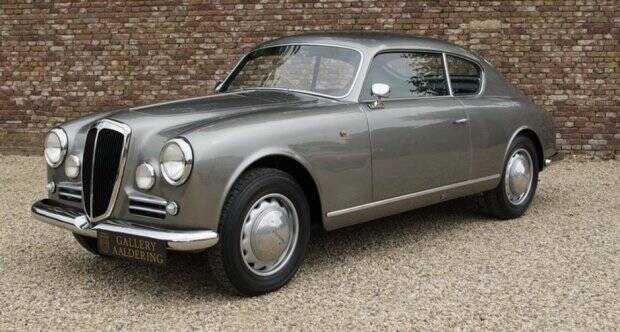V-6 engines are now the “big” engine on the North American automotive scene, the role the V-8 used to fill. They offer ample power, performance and economy in a package that’s easier to accommodate, especially mounted transversely in front-wheel drive cars with shrinking engine bays that are typically filled with fours.
The V-6 is a relatively recent arrival in automotive history and we can thank the Italians for the world’s first production car V-6. It arrived in 1950 in the Lancia Aurelia. The first American V-6 was in a GMC truck in 1960; the first car was the 1962 Buick Special.
The Aurelia V-6 bowed at the 1950 Turin Auto Show. Lancia history dated from 1906 and it was known for its technical novelty and engineering excellence.
The Aurelia V-6 displaced only 1754 cc and developed 56 horsepower at 4,000 rpm. Power and displacement would increase several times over the Aurelia’s life.
The overhead valve V-6 had an aluminum block and heads with pistons running in wet sleeves. A 60 degree bank angle (narrow angle vee engines were a Lancia specialty), gave the V-6 even firing intervals. It had hemispherical combustion chambers, and the use of unusual bell-crank rocker arms also helped keep the engine narrow.
In addition to its technically interesting engine, the rest of the Aurelia was also quite advanced. Rather than mounting the column-shifted four-speed manual transmission behind the engine in conventional fashion the Aurelia’s was combined with the differential in a rear transaxle for better weight distribution.
Suspension was all-independent using coil springs with Lancia’s sliding pillars (a Lancia feature since 1922) in front and semi-trailing arms at the rear. It was said to be the first use of trailing arm rear suspension. Inboard rear brakes also reduced unsprung weight.
For convenience the Aurelia sedan had no pillar between the front and rear-hinged rear doors. The sedan was well received but it was the Aurelia Gran Turismo coupe introduced in 1951 that really consolidated the model’s reputation. It would almost single handedly launch the two-plus-two GT genre.
The sleek unit-construction fastback styled by Pinin Farina was ideally suited for luxurious touring for two on Europe’s grand motor routes. An open Spider model was also offered.
The GT’s styling and technical sophistication were wrapped in a very compact package. Over-all length was 4,267 mm (168 in.), wheelbase was 2,668 mm (105 in.) and weight was only 975 kg (2,150 lb.). Engine displacement was soon increased to 1,991 cc which gave 75 horsepower, more appropriate for this class of car.
But the question yet to be answered was whether the GT’s handling, performance and durability matched the promise of its sophisticated technology. The Aurelia GT quickly proved its speed, road holding and robustness when just three days before introduction GTs finished first and second in the Tour of Sicily’s over-1500 cc GT class.
A couple of months later it astounded everyone by finishing second in the 1951 running of the legendary Italian Mille Miglia (1,000 mile race). The 75 horsepower Lancia was beaten only by a 200 horsepower Ferrari with twice the engine displacement. It also finished first in its class in the 1951 Le Mans, France 24-hour race.
The Aurelia came to the attention of North Americans in 1952 when a supercharged GT finished fourth overall in the sports car class of the wild and gruelling 3,114 km (1,934 mi.) Carrera Panamericana a.k.a. Mexican Road Race. It was beaten only by two of Mercedes-Benz’s fabulous new 300SLs and a Ferrari.
To prove this was no fluke, Lancia came back to Mexico the following year and swept its class one-two-three.
In road trim the GT was quite spirited. The British motoring journal Autocar tested a Series 4 version in 1954 (it ultimately reached Series 9), by now up to 2,451 cc, and recorded zero to 97 km/h (60 mph) in 12.3 seconds and top speed of 180 km/h (112 mph).
This was the year the semi-trailing arm rear suspension was replaced by a de Dion type with leaf springs supplanting the coils. The de Dion solid axle kept the wheels perpendicular to the road for more predictable handling.
Although a few Lancia Aurelias were imported into North American they never enjoyed much popularity, mostly because they were quite expensive (up to $6,000). So while it was highly respected in Italy, the Lancia name was not well known here.
Production of the Lancia Aurelia continued until 1958. During its nine year run over 4,000 GTs and Spiders and approximately 15,000 regular sedans were produced.
Although never reaching high production the Lancia Aurelia set an international engineering benchmark with its pioneering V-6 engine and Gran Turismo styling. It was an early template for the compact, agile and technically sophisticated two-plus-two luxury touring GT.



